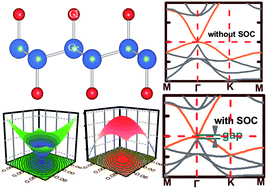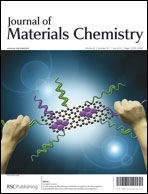Halogenated two-dimensional germanium: candidate materials for being of Quantum Spin Hall state†
Abstract
The electronic band structure of halogenated germanene in the presence of spin–orbit coupling is investigated using first-principles calculations. Our results demonstrate that, compared with pure germanene, the π and π* bands of germanene adsorbed with Cl, Br and I remain crossed at the Fermi level – despite the crossing point shifting from K to Γ points. Moreover, we find that appreciable gaps in halogenated germanene can be opened at Dirac-like points, several orders of magnitude larger than that in pure germanene due to the robust spin–orbit coupling; for example, Cl, Br and I yield a SOC-induced gap of 86 meV, 237 meV and 162 meV at Γ points, respectively. In addition, since the germanene would be unstable at ambient conditions due to the dangling unsaturated Ge bonds, the manufacture of fully halogenated germanene with a robust spin–orbit coupling effect is more feasible than that of germanene experimentally. Therefore, our work may provide a potential avenue to observe the Quantum Spin Hall Effect at room temperature.


 Please wait while we load your content...
Please wait while we load your content...